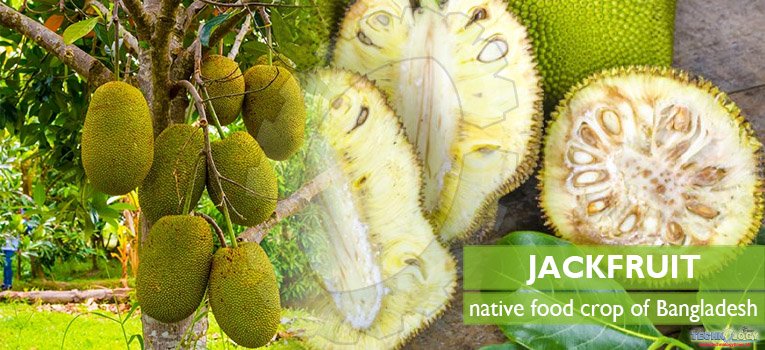Different fruits have different charms, jackfruit is one of them. The word jackfruit comes from Portuguese ‘Garcia de Orta’, physicians firstly named it in 1953 in his book. In Urdu, it is called Kathal. Its botanical name is Artocarpus heterophyllus and family belongs to Moraceae.

Its order is rosales in kingdom plantae. Its genus is Artocarpus. It is native to South India. South India includes cities like Andhra Pradesh, Karnataka, Tamil Nadu, Kerala etc. In India, Jackfruit plays a significant role in agriculture sector.
Jackfruit is popular in tropical regions. It is the national fruit of Bangladesh, has largest tree-borne of fruit. Jackfruit is reliable sources of vitamin C. It’s seeds are rich in proteins, calcium and in iron as well. One fruit of jackfruit contains 100 calories approximately.
Generally, its weight is 35 kg, 90 cm in length and 50 cm in diameter. It’s leaves are oval in shape and dark green in color. Jack fruit produce 100 to 200 fruits in a year. It is a multiple fruit which contains hundreds of thousands of individual flowers. Jackfruit has a beautiful and sweet taste. When we boil jackfruit, it tastes like a potato. India, Bangladesh, Indonesia and Nepal are major exporters of jackfruit.
Cultivation of Jackfruit
Jackfruit belongs to humid tropical region. It is sensitive to frost and cannot tolerate drought. For cultivation warm and sunny season is required. It is rich in deep soil. It is grown more slowly in limestone rich soil. It has best soil pH range between 6.0 to 7.5.
Jackfruit should be growing in flat land. Planting should be from 8 to 10 meters. In hilly areas, planting should be done according to their slopes of the land. Jack fruit propagated through seed and germination can be done from 3 to 8 weeks. Budding and grafting is not successful.
Vegetative cutting and tissue culture give better results. Pruning is unnecessary for young tree. Pruning can be done only for removal of disease parts of the tree. It should be ripened from March to June or from April to September.
Fruit maturity requires 3 to 8 months from flowering. After harvesting, it becomes good in flavor. Hand pollination can be very successful. In India, 150 large fruit per tree is a good yield. Almost these types of fruits are medium or small in size.
Jackfruits turn brown and become worse quickly after ripening. Fruit can be kept 3 to 6 weeks under 52oC to 55oC. Relative humidity can be require from 85 to 95%. In summer, daily water the immature tree. Fertilizers are not necessary for its tree.
Weeding can be done after every 3 months. So, fruit can be bear from 10 to 14 years and improved varieties can be bear from 4 to 5 years. It has several varieties like Koozha, Pazham, Singapore, Ceylon, Safeda, Khaja, Bhusila, Handia; and T Nagar Jack are the best varieties.
Health benefits
Jackfruit leaves are useful for skin disease and curing fewer. Its seeds are useful for blood circulation, and contain zero cholesterol and benefit for carbohydrates and energy. It is very good for blood pressure patient as well. And also good for human digestion system and stops constipation.
Jackfruit also improves vision of eyesight. By eating, heart failure losses can be reduced. It is very useful to treat asthma. And also useful for human bones. Its seeds can be used for healthy hairs. We can also use it in soups, chips, jams or in ice-cream.
The wood of its tree is useful for manufacturing musical instrument, furniture door etc. The roots keep us away from diarrhea. Its production is 2082.32 tons per year in India.
It contain shoot-borer caterpillar, mealy bugs, spittle bug and jack scale insect pest. Important diseases of jackfruit are pink disease, stem rot, fruit rot, gray blight, collar rot, charcoal rot etc.
M. Abbas1, Rashad Muhktar Balal1, M. Ali Khakwani2 (1Department of Horticulture, College of agriculture, University of Sargodha) (2Department of Horticulture, 2BZU, Multan)
